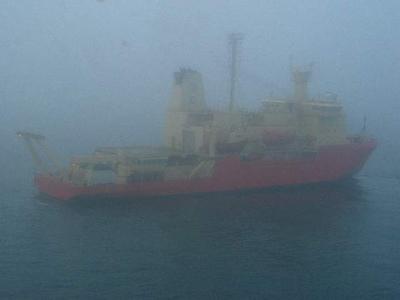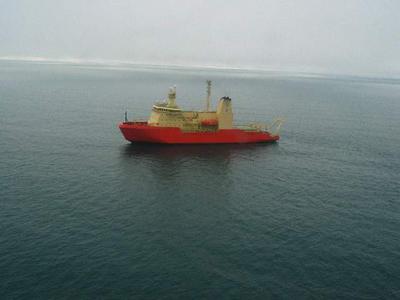
|
|
4 August, 2003
We reached our highest latitude of the voyage at about noon today, or
put another way, our furthest north. My preconceived mental image
pictured a bitter cold, pure white icescape sculpted smooth by the
wind. Instead, our furthest north at 74 degrees and 23 minutes
turned-out to be relatively ice free, and the sea was choppy and
gray. In fact, it was raining!
My misconception reminded me of an observation made by the Greek
geographical thinker Strabo who noted, "The sailor on the open sea,
or the man who travels through a country, is guided by certain
popular notions." And it has always been this way.
Tradition has it that the three voyages of Captain James Cook between
1768 and 1779 represented a proverbial testing of the theoretical
waters. Influenced heavily by a potent mixture of myth and reality,
geographical thinkers of the day asserted the following: (1) a
great, unknown continent lay in the vast reaches of the southern
Pacific Ocean; (2) the western entrance to the Northwest Passage was
located somewhere along the rocky coastline of northwestern North
America; and, (3) an ice free polar sea would permit easy navigation
between the Pacific and the Atlantic. It was left to Cook and his
crew to test those waters, and as the Captain demonstrated, on all
three counts the armchair theorists were wrong. Nonetheless, Cook
was instrumental in accelerating the exploratory process that
ultimately revealed the true nature of the Pacific basin.
In a way, we too are explorers, probing the depths and the inner
workings of the Arctic Ocean. Although we are largely focusing on
what lies below the surface, the scientists and technicians on board
the Research Vessel Nathaniel B. Palmer are simply fulfilling their
parts of the exploratory process. Like blank areas on a map, the
empty spaces between our lines of stations invite speculation about
the nature of the waters’ properties where we have no data.
So in the spirit of oceanographic exploration, I can't help but
wonder what it's like at 75 degrees north.

The R/V Palmer plying the northern mists. Both images of the Palmer were taken by Chief Mate, Mike Watson from the ship's helicopter.

The Research Vessel Nathaniel B. Palmer on its voyage of oceanographic exploration.
Contact the TEA in the field at
.
If you cannot connect through your browser, copy the
TEA's e-mail address in the "To:" line of
your favorite e-mail package.
|
